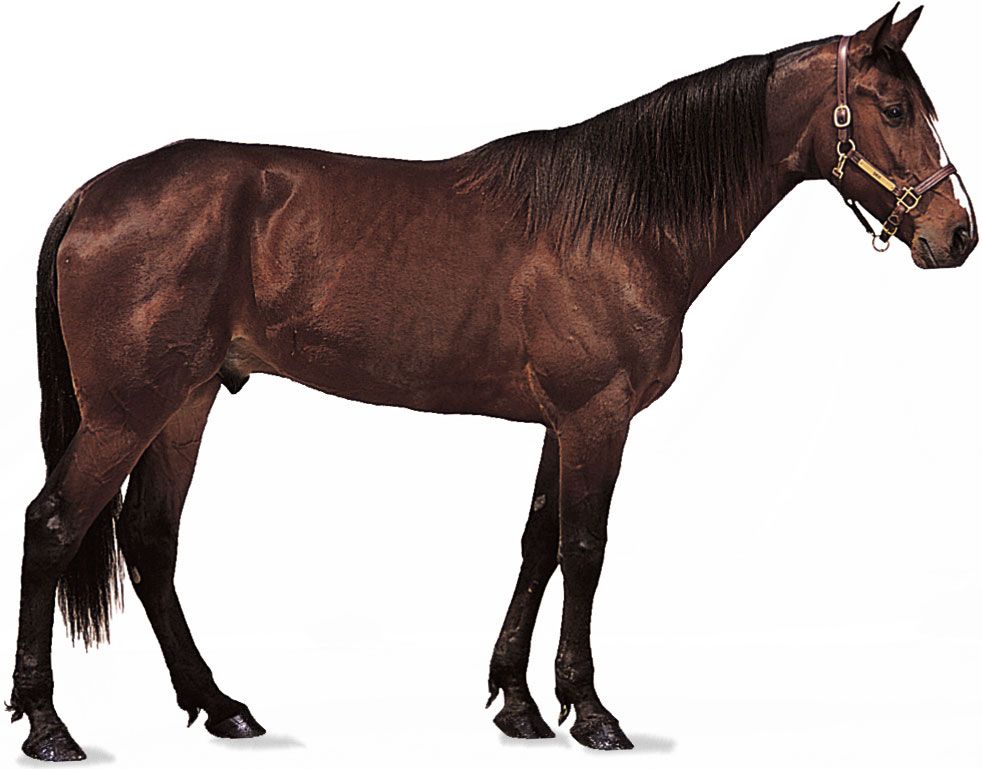Horses are magnificent creatures that have roamed the Earth for thousands of years. They are one of the most beloved animals around the world. Let’s dive into the fascinating world of horses and explore their history, interesting facts, size, habitat, and classification.
History: Horses have a rich history that dates back to ancient times when they were used for transportation, farming, and warfare. They were first domesticated around 4000 BC and have played a significant role in the development of civilizations ever since. Horses have been loyal companions and have helped humans in various ways throughout history.
Facts: Did you know that horses can sleep both lying down and standing up? It’s true! Horses have a unique ability to sleep in both positions to ensure they are always ready to react quickly to potential dangers. Additionally, horses are known for their incredible speed and endurance. They can gallop at speeds of up to 30 miles per hour and maintain it for a lengthy distance.
Size, Habitat, and Classification: Horses come in different sizes, ranging from small ponies to large draft horses. They vary in height and weight depending on their breed. Horses are usually found in grassy plains and open areas where they can roam freely. They are herbivores, feeding on grass and other vegetation. In terms of classification, horses belong to the Equidae family and are part of the genus Equus.
In this blog, we will delve further into the world of horses, exploring their anatomy, behavior, and their unique bond with humans. Join us as we uncover the captivating world of these majestic animals! Stay tuned for more interesting articles on Animals Name.
History of Horse
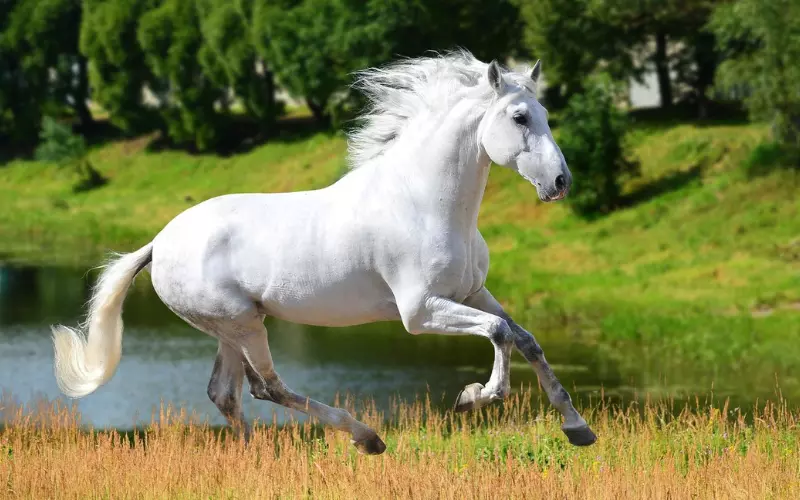
The horse has been an important animal throughout history. It has been a loyal companion to humans and has helped us in various ways.
In ancient times, horses were used mainly for transportation. They were faster and stronger than humans, which made traveling long distances easier. People would ride horses or use them to pull carriages and chariots. Horses were also used in battle, giving warriors a great advantage. They could charge into the enemy with speed and force, helping to win wars.
As time went on, horses became even more important. They were used in agriculture, helping farmers plow fields and carry heavy loads. Horses were also used in industries such as mining and logging, where their strength was essential. They were even used in mail delivery, carrying letters and packages across long distances.
Today, while horses are no longer the primary mode of transportation, they are still highly valued. They are used in sports like horse racing and show jumping, where their speed and agility are showcased. Horses are also used in therapy programs, as they have a calming effect on people and can help individuals with disabilities improve their physical and mental well-being.
The horse has played a significant role in human history. From being a means of transportation and a powerful asset in battle to assisting with various tasks and providing leisure and therapeutic benefits, the horse continues to be an important and cherished animal in society.
Importance of Horse
Horses are incredibly important animals and have been our companions for thousands of years. They are not only beautiful and majestic, but they also serve many practical purposes. One of the most significant roles horses have played is in transportation. Before cars were invented, horses were the primary mode of transportation for people and goods. They could travel long distances, carry heavy loads, and were reliable partners for humans.
Furthermore, horses have been vital in agriculture. They helped farmers plow fields, transport crops, and perform other tasks necessary for food production. This made farming more efficient and increased the availability of food for communities. In addition, horses have been used in sports and leisure activities. They have been a part of various competitions, such as horse racing and showjumping, providing entertainment and excitement for spectators.
Moreover, horses have had a significant impact on warfare throughout history. They were used as mounts for soldiers, allowing them to move quickly and engage in battle. They also pulled chariots and carried supplies, contributing to the success of armies. In modern times, while horses are no longer used in warfare, they continue to have an important role in police work, search and rescue operations, and therapy for individuals with disabilities.
Horses hold great significance in our lives. They have served as transportation, aided in agriculture, provided entertainment, and played crucial roles in warfare. Their strength, agility, and beauty make them remarkable creatures that have enhanced and shaped human civilization throughout history.
Amazing Facts About Horse
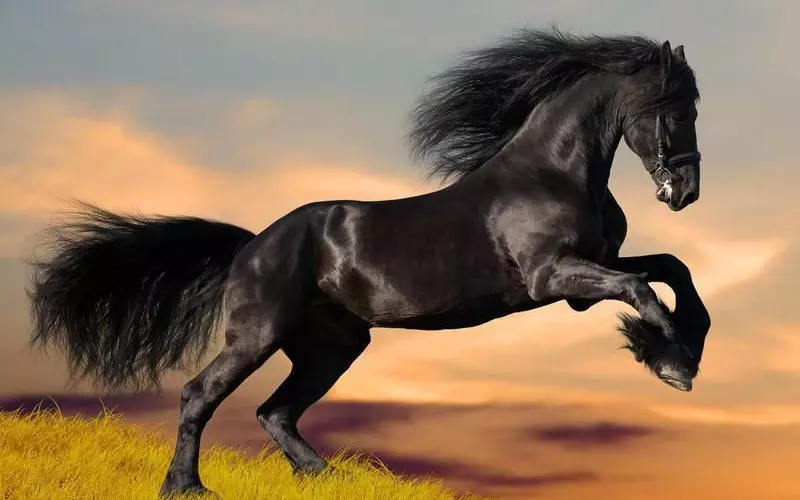
1. Horses are large, strong, and beautiful animals that have been domesticated for thousands of years.
2. They come in various sizes and breeds, with the average height being around 4-6 feet at the shoulders.
3. Horses have distinct long tails and manes that can be of different colors, such as black, brown, white, or gray.
4. Known for their speed and agility, horses can run at speeds of up to 27 miles per hour.
5. Horses are herbivores, which means they only eat plants and grass, feeding on hay, grains, and fresh pasture.
6. They have a strong sense of hearing, allowing them to detect sounds from long distances and maintain awareness of their surroundings.
7. Horses communicate through various body signals, such as neighing, whinnying, or stomping their hooves.
8. They are highly social animals and usually live in herds where they establish strong bonds and hierarchy.
9. Horses have been used by humans for transportation, work, and companionship for centuries.
10. They have a great memory and can remember places, routes, or people even after long periods.
11. Horses have excellent eyesight, capable of seeing almost 360 degrees around them, but they have a small blind spot directly in front of their nose and directly behind them.
12. They have four powerful legs with hooves that are made of a tough material called keratin, which allows them to walk, run, and gallop.
13. Horses sleep both lying down and standing up, as they have a unique system of ligaments and tendons that allows them to do so.
14. They have the ability to feel and express emotions, including happiness, fear, and sadness.
15. Horses require regular grooming, exercise, and veterinary care to ensure their health and well-being.
Can we keep a Horse as our Pet?
Keeping a horse as a pet can be a big responsibility. Horses are large animals that need special care and attention. They require a lot of space to live comfortably and need to be fed properly. Additionally, horses need regular exercise and grooming.
Firstly, horses need a lot of space to live happily. They need a large, fenced-in area where they can move around freely. If you don’t have enough land, it may not be suitable to keep a horse as a pet. Horses also need shelter from the weather, such as a stable or a shed, to stay safe and dry.
Secondly, horses require proper nutrition to stay healthy. They need a specific diet that includes hay, grains, and freshwater. It’s important to provide balanced meals for them. Moreover, horses also need regular check-ups from a veterinarian to ensure they are not suffering from any diseases or ailments.
Finally, horses need regular exercise and grooming. They are highly energetic animals that thrive on physical activity. They need to be ridden, walked, or played with regularly to keep them happy. Grooming is also essential as it helps to keep their coat clean and free from knots.
Keeping a horse as a pet requires a lot of space, proper nutrition, exercise, and grooming. It is a big responsibility that should not be taken lightly. If you have the means to provide all these things for a horse, then it can be a wonderful and rewarding experience to have them as a pet. However, if you are unable to meet their needs, it is best to consider alternative pets that are more suitable for your living situation.
Size of Horse
Horses are magnificent animals that come in various shapes and sizes. The size of a horse depends on its breed and its purpose, which can be riding, racing, or working in fields. Generally, horses have an average height between 14 and 17 hands, with one hand being equivalent to four inches. So when we say a horse is 14 hands tall, it means it stands around 56 inches high at the shoulder. Just imagine, horses are usually much taller than humans!
The different breeds of horses can also vary in their weight. The average weight of an adult horse is around 900 to 2,200 pounds. That is as heavy as a small car! The size and weight of a horse are important factors to consider when selecting the right one for a specific task or activity. Some smaller horses, known as ponies, have similar features to horses but are smaller in size. They are often used for children to ride or for pulling light carts.
In addition to their size, horses have long legs and a strong body that allows them to run fast and carry heavy loads. Despite their large size, horses are gentle creatures and can be trained to be friendly and obedient. They are truly remarkable beings, both in terms of their physical size and their remarkable abilities.
Habitat of Horse
Horses can be found in many different places around the world. They live in habitats that vary from hot deserts to cold mountains. Horses are adaptable animals that can survive in different environments as long as they have access to food and water.
One of the main habitats for horses is grasslands. They thrive in open areas with plenty of grass to eat. Grasslands provide horses with the perfect environment to graze and roam freely. These open spaces allow horses to run and play, making it their ideal living space.
Another habitat for horses is forests. Forests provide horses with shelter and protection from harsh weather conditions. The trees and dense vegetation in the forest offer shade and keep the horses cool during hot summer days. Horses in the forest can also eat leaves and twigs from low-hanging branches, providing them with additional sources of food.
Lastly, horses can also be found in mountainous regions. Their hooves are especially adapted to climbing rocky terrains. Horses in the mountains often live in herds and are able to navigate steep slopes and rugged landscapes. These habitats may have less vegetation, but horses can find food in the form of shrubs, grass, and moss.
Overall, horses can be found in a variety of habitats, including grasslands, forests, and mountains. They have adapted to survive and thrive in different environments by finding sources of food and water. Whether it’s the open grasslands, the sheltered forests, or the challenging mountains, horses can call many places on Earth their home.
Classification of Horse
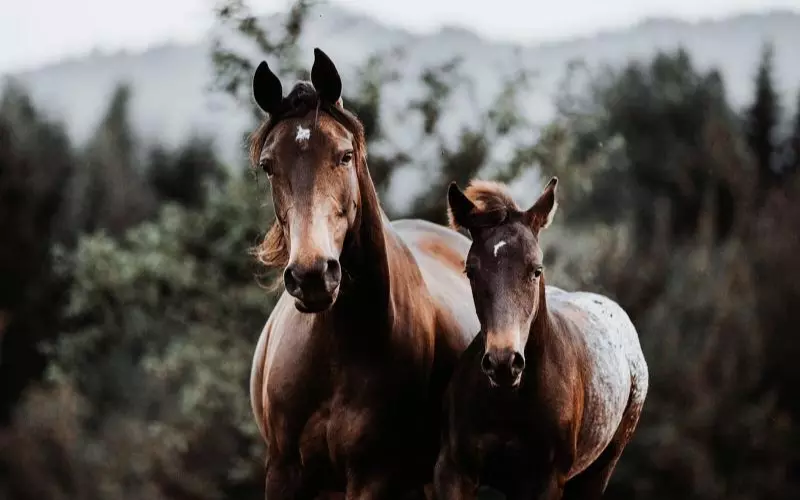
The horse is a majestic animal that belongs to the Equidae family. Within this family, there are seven recognized species of horses. These species can be further classified into various breeds, each with its distinct characteristics. Horses are generally divided into three main types based on their build and purpose: draft horses, light horses, and ponies.
Draft horses, also known as heavy horses, are robust and strong. They are exceptionally muscular and were historically used for heavy farm work and pulling heavy loads. They have a stocky build and can weigh up to two thousand pounds. Clydesdale, Percheron, and Shire are some examples of draft horse breeds.
Light horses are more agile and were bred for riding, racing, and other athletic activities. They have a well-rounded body structure and are known for their speed and endurance. Thoroughbred, Arabian, and Quarter horses are popular light horse breeds found around the world.
Ponies are smaller in size compared to both draft and light horses. They are known for their hardiness, intelligence, and strong temperament. Ponies can be used for various purposes, including riding, driving, and as companion animals. Some well-known pony breeds include Shetland, Welsh, and Icelandic ponies.
Horses can be classified into draft horses, light horses, and ponies based on their build and purpose. Each type of horse has its own unique characteristics and traits. Horses have played a significant role in human history and continue to bring joy and companionship to many people around the world.
Different Types of Horse
1. Thoroughbred: Thoroughbred horses are famous for horse racing due to their speed and agility. They have a sleek body and long legs, allowing them to reach high speeds. Their brave and competitive nature makes them popular choices amongst jockeys and spectators alike.
2. Arabian: Arabian horses are known for their beauty and elegance. They have a distinctive head shape with a concave profile and expressive eyes. These horses possess great endurance and are often used for long-distance riding or endurance races.
3. Quarter Horse: As the name suggests, Quarter Horses excel in short-distance sprints, particularly in quarter-mile races. They are muscular, compact, and speedy, making them ideal for activities like rodeo events, barrel racing, and cutting cattle.
4. Paint Horse: Paint Horses are cherished for their striking coat patterns, which are a combination of white and another color. They possess a gentle disposition and are versatile, excelling in various disciplines such as western pleasure, trail riding, and show jumping.
5. Appaloosa: Appaloosa horses are famous for their colorful spotted coat patterns, which can range from leopard-like spots to blankets or roan markings. They are intelligent, agile, and often used in western riding disciplines, including cutting, reining, and rodeo events.
6. Morgan: Morgan horses have a sturdy build, compact frame, and expressive eyes. They were initially bred for transportation but later gained recognition as all-around horses, excelling in driving, dressage, jumping, and trail riding. Their versatility and willingness make them popular choices for riders of all ages and abilities.
7. Clydesdale: Clydesdale horses are large and muscular, known for their feathered feet and distinctively high-stepping gait. Originally bred for heavy work, they are now popular for parades, showmanship, and pulling carriages due to their impressive appearance, strength, and gentle nature.
8. Tennessee Walking Horse: Tennessee Walking Horses are famous for their unique four-beat running walk gait, which provides a smooth and comfortable ride. With their calm temperament, they are often chosen for pleasure riding, trail riding, and showing competitions.
9. Shetland Pony: Shetland Ponies are small but sturdy equines known for their thick manes and fluffy coats. They are intelligent, hardy, and famous as children’s riding ponies due to their diminutive size and gentle temperament.
10. Haflinger: Haflingers are small to medium-sized horses originating from Austria. They possess a chunky build, sturdy conformation, and a thick, flowing mane and tail. These versatile horses are suitable for various equestrian activities, including pleasure riding, driving, and light farm work, due to their strong work ethic and pleasant nature.
Geographical Presence of Horse
The horse is found in many regions around the world. They can be seen in places like North America, Europe, Asia, and Africa. Horses have been domesticated for thousands of years and can be found on farms, ranches, and even in some cities where they are used for transportation or recreation.
However, there are also regions where horses are not found. One such region is Antarctica, as it is too cold and harsh for horses to survive. The extreme temperatures and lack of vegetation make it difficult for these large animals to find enough food and stay warm. Similarly, horses are not native to the Amazon Rainforest in South America due to its dense vegetation and humid climate.
Overall, horses are adaptable creatures and can thrive in various regions across the globe. They have been an important part of human history and continue to play a significant role in many societies. Whether it is for work, sport, or companionship, horses have found their place in many different parts of the world. However, there are still some regions, like Antarctica and the Amazon Rainforest, where you won’t find these magnificent animals.
Diet of Horse’s
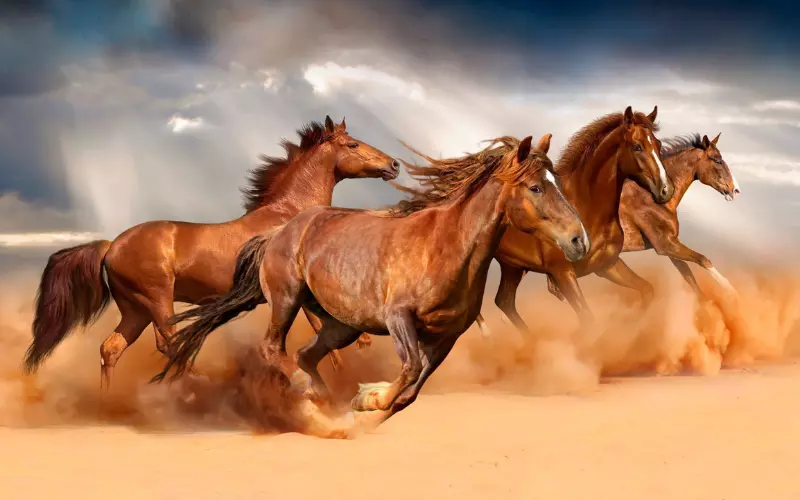
Horses need a well-balanced diet to stay healthy and strong. Their diets mainly consist of grass and hay, which provide them with essential nutrients like carbohydrates, proteins, and fiber. Grass contains lots of water and energy, helping horses maintain a good digestive system.
In addition to grass and hay, horses also need some grains to give them extra energy. Oats, barley, and corn are commonly used grains in a horse’s diet. These grains are rich in carbohydrates and provide horses with the energy they need for work or play. However, it’s important not to give them too much grain because it can cause digestion problems.
Besides grass, hay, and grains, horses also need minerals and vitamins. They can get these from special horse supplements or from grazing in pastures that have a variety of plants. These minerals and vitamins are essential for the growth and development of horses, as well as to keep their immune system strong.
To summarize, horses have diets that consist of grass, hay, grains, and supplements or grazing in pastures. These different foods provide them with the energy they need to stay active and the nutrients to keep them healthy. It’s important for horse owners and caretakers to ensure that horses receive a well-balanced diet to maintain their overall well-being.
Locomotion of Horse’s
Horses move in a special way called locomotion. They have a unique way of walking called the walk, trot, canter, and gallop. When a horse walks, it lifts and swings its legs forward in a steady rhythm. This helps the horse to move slowly and carefully, like when it’s pulling a wagon.
Next, horses can trot, which is a faster and bouncier way of moving. They lift their front and back opposite legs together, which creates a steady and quick motion. While trotting, horses move in a more lively manner.
Then comes the canter, where the horse moves even faster. In the canter, it hops with its back legs and stretches its front legs in a long stride. This smooth and swift way of moving allows the horse to travel swiftly on the ground.
Finally, there’s the gallop, which is the fastest way horses move. During a gallop, the horse stretches its legs to the fullest. It uses all four legs to push itself off the ground, which helps it move quickly and gracefully.
To conclude, a horse’s locomotion includes different ways of moving, like walking, trotting, cantering, and galloping. Each of these movements allows horses to travel at different speeds and adapt to various situations.
Social and Sexual Behaviour of Horse’s
Horses are fascinating creatures that have interesting social and sexual behaviors. They are very social animals and live together in groups called herds. In a horse herd, there is usually one dominant male known as the stallion, and several females known as mares. The stallion protects the herd and mates with the mares to produce offspring.
The social behavior of horses involves communication and establishing a hierarchy. They use various signals such as body language and vocalizations to interact with each other. Horses are known to groom each other, which helps to build trust and strengthen their social bonds. They also have a strong sense of leadership and follow a pecking order within the herd.
When it comes to sexual behavior, horses have a mating season called estrus. During this time, the mares become receptive to the advances of the stallion and may show signs like raising their tails and urinating frequently. The stallion, on the other hand, becomes more protective and tries to keep other males away from the females. Once they mate, the gestation period for a horse is about 11 months, after which a foal is born.
Horses are social animals that live in herds and have a structured hierarchy. They communicate through body language and vocalizations, and grooming is an essential part of their social behavior. When it comes to mating, they have a specific season called estrus, during which the stallion mates with the receptive mares. The life of a horse is filled with fascinating social and sexual interactions.
Reproduction and Lifecycle of Horse’s
The reproduction and life cycle of horses is fascinating. Let’s learn about how horses bring new life into the world and grow from a baby to an adult.
Horses reproduce through a process called mating. A male horse, called a stallion, mates with a female horse, called a mare. This usually happens in the spring or summer months. The stallion mounts the mare and they engage in a special dance called “courtship.” After mating, the male carries the baby horse, called a foal, in her womb for about 11 months. This is a long time compared to many other animals!
When the time is right, the mare gives birth to her foal. The foal is already big and strong, ready to stand and walk within an hour of being born. The foal drinks its mother’s milk for several months, which gives it the necessary nutrients to grow. As the foal gets older, it slowly stops relying on its mother’s milk and starts eating grass and other food.
As the foal grows, it becomes a yearling, then a two-year-old, and finally reaches adulthood. Horses usually reach their full size and maturity by the time they are four years old. Throughout this journey, horses need lots of love, care, and attention from their human companions. They are amazing creatures that can live for around 25 to 30 years if they are well taken care of.
And that’s the incredible story of how horses reproduce and grow. From a tiny foal to a majestic adult, horses are truly magnificent animals that remind us of the beauty and wonder of nature.
Threats to Horse’s
Horses face many threats that can harm them and reduce their numbers. One major threat to horses is disease. Just like humans, horses can catch sicknesses that can make them very sick or even cause death. Some common diseases that affect horses are influenza, strangles, and West Nile virus. Horses also need to be protected from parasites like worms and ticks, as they can cause serious health problems.
Another threat to horses is the loss of habitat. Horses need a place to live and roam freely. Unfortunately, human activities such as urbanization and farming have decreased the amount of land available for horses. This means they have less space to run and find food. Without enough suitable habitat, horse populations can decline.
Lastly, horses are sometimes hunted or killed by predators. Coyotes, wolves, and even domestic dogs can attack and harm horses. These predators may perceive horses as food or see them as a threat to their territory. To protect horses from predators, it is important to keep them in secure enclosures or pastures where they are less likely to be targeted.
Horses face threats such as diseases, loss of habitat, and predation. These dangers can harm horses and decrease their populations. To help protect horses, it is important to provide them with proper veterinary care, ensure they have enough habitat to live in and take measures to prevent attacks from predators.
Conclusion
In the vast world of Animals Name, one creature that has captured our hearts and minds is the horse. With a fascinating history, interesting facts, and unique characteristics, the horse truly stands out among its animal companions.
Throughout history, horses have played a crucial role in human civilization. They were first domesticated thousands of years ago and have since become loyal companions and dependable modes of transportation. From ancient warfare to agricultural work, horses have aided humans in many ways. Their intelligence, strength, and speed make them a powerful ally in various human activities.
In addition to their historical significance, horses possess intriguing facts that make them even more captivating. Did you know that a horse’s size can vary greatly depending on its breed? From the small and sturdy Shetland pony to the majestic and towering Clydesdale, horses come in many shapes and sizes. Moreover, horses have adapted to various habitats around the globe, making them a truly versatile species.
The horse is a remarkable creature that has left an indelible mark in the animal kingdom. Their rich history, fascinating facts, and adaptability make them an intriguing subject of study. As we explore the diverse and fascinating world of Animals Name, the horse stands tall as an animal of remarkable strength, beauty, and importance.
FAQ’s
What is a horse?
A horse is a large, four-legged animal with a mane, tail, and hooves, often used for riding, racing, or farm work.
What is the average lifespan of a horse?
The average lifespan of a horse ranges from 25 to 30 years, although some horses have been known to live into their 40s.
What are the different breeds of horses?
There are numerous breeds of horses, including Thoroughbreds, Arabians, Quarter Horses, Appaloosas, and many more.
How fast can a horse run?
Horses can run at speeds of up to 40 to 45 miles per hour, depending on the breed and individual horse.
What is the gestation period of a horse?
The gestation period for a horse is approximately 11 months or around 340 days.
How tall can horses grow?
The height of horses can vary significantly, ranging from around 4.5 to 6 feet at the shoulder, depending on the breed.
Are horses herbivores or carnivores?
Horses are herbivores, meaning they primarily eat plants and vegetation.
What is the term for a female horse?
A female horse is called a mare.
What is the term for a male horse?
A male horse is called a stallion if it is not castrated, or a gelding if it has been castrated.
How much does a horse weigh?
The weight of a horse can vary depending on the breed, but it usually ranges from around 900 to 2,200 pounds.
Are horses social animals?
Yes, horses are social animals and often form strong bonds with other horses.
How do horses communicate?
Horses communicate through a combination of body language, vocalizations, and expressions.
How long does it take for a horse to reach full maturity?
Horses typically reach full maturity between the ages of four and five years old.
Can horses swim?
Yes, horses are natural swimmers and can navigate through water using their powerful legs and buoyancy.
Can all horses be ridden?
While most horses can be ridden, not all horses are trained or suitable for riding purposes. Some horses are intended for other activities such as driving, while others may be retired or used solely for breeding.

Hi there! I’m Morgan Gutierrez, and I love animals! I work as a Seasonal Animal Care Specialist at Brookfield Zoo and also teach people about animals, which is super fun. I studied at Valparaiso University in Lockport, Illinois, where I learned even more about these amazing creatures.
I’m not just about taking care of animals; I write articles about them, too! I explore and share many interesting animal stories, from cute kittens to giant elephants.
In the past, I’ve worked with veterinarians, helped with research, and even been an Animal Ambassador, bringing animals closer to people. Animals are my passion, and I enjoy helping others learn about them. So, if you ever want to know about animals, feel free to ask. I’ll explain it in a way that’s easy to understand, just like talking to a friend!

